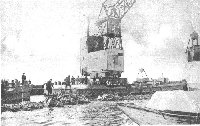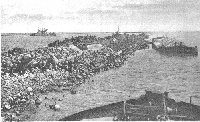
Last change:
30-3-2000;
reactions?
e-mail me
The history of Wieringen
the "Zuiderzeewerken"; the end of Wieringen as an island
Before the "Zuiderzeewerken", the great infrastructural works of the 1920's, began, Wieringen was a remote island. If you wanted to visit it, you first had to travel from Schagen to Van Ewijcksluis with a small steamtrain, and from there you needed to take the mailboat to cross the water to De Haukes, which was for a long time the only harbour of Wieringen. A visit to a major city took several hours, and even then you were only in Den Helder, or in Alkmaar.
Plans to close the Zuiderzee
Shortly after Worldwar 1, Wieringen found itself in the spotlights, due to the exile of the German ex-crownprince on the island. After this eventful period Wieringen would have sunk back into oblivion, if the work on the project to
close off the Zuiderzee had not started a few years later. For more than 100 years plans had been made to
close the inland sea off, and regain land from it. Technical and financial problems were for a long time the reason why it stayed with plans, but due to the floods of 1917 politicians gave the green light for the project in the 1920's. The choice fell on the plan of ir. Lely, who as important politician could do some serious lobbying for his project. The plan comprised of dikes being constructed from North Holland to Wieringen, and from Wieringen to the Friesland province. In the Zuiderzee 5 polders were to be made, the first of which would connect Wieringen further to the mainland of North Holland: the Wieringermeer.
More info on the different land-regaining plans on a separate page.
The work starts
The effects for Wieringen
1932: the work is finished

| May 28th 1932 was the big day: the completion of the dike. For five long years dikes from both sides slowly approached each other, and on this day the last freights of clay and stone closed the dike and connected the two ends. The closure would change a lot of things. First of all the Zuiderzee, no longer a sea, was renamed to IJsselmeer; the Zuiderzee-fishing industry collapsed because of the change of currents and certain species of fish disappearing. Only in Volendam, Urk and Wieringen a fishing community survived, mainly because they fished in open sea and not in the Zuiderzee. The Afsluitdijk also meant that you could get much faster to Friesland from North-Holland. A begin was made to regain large pieces of land from the sea, and most important, certainly for this story, Wieringen had undergone the greatest changes in its history. No longer an island local economy could expand, finding new markets on the mainland. The smarter children could continue their education more easily, now there was a good connection to cities as Den Helder and Alkmaar. For a long time there were plans to make a railroad over the Afsluitdijk, but soon it was apparent that traffic by automobile showed enormous growth and priority was given to building a motorway. Later the astronomically high costs no longer justified making the railroad and the reserved strip of the dike was turned in to a second lane for the motorway. The railroad-that-never-was is still the cause for a curious sight on Wieringen. a strip of land, parallel to the N99 road from Den Oever to Den Helder has been waiting for the railroad for more than 70 years now. Near Westerland some preliminary work was even done by diggin a ditch for the railroad track, so that the railroad would lie level. Only in very recent years the land can be used for other purposes, and slowly the memories of the never existing railroad fade away. Until recently this seemed a lot of wasted money, but now in 1999, more than 70 years later, the motorway is partly moved into the railroadditch. (See webpage by the constructor) This way two scars in the Wieringer landscape are removed. |  An old picture of the monument on the Afsluitdijk. The inscription on it says: A people that lives, builds its own future |


